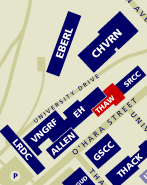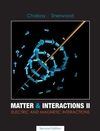|
Home
Calendar
WebAssign
VPython
Files |
Times
- Wednesday and Friday
2:00 PM to 3:40 PM, Recitation Monday 2:00 PM to 2:50 PM
(Be sure you are registered for the course and the recitation section.)
-
- 210 Thaw Hall
 
People
- Dr. Adam Leibovich, Professor
- Office hours: Wednesday
from 10:00 to 12:00 or by appointment in my office 200K Allen Hall
- Office: 200K Allen
Hall
- Tel. 624-3617
- E-mail: use WebAssign's
Private Messages or if about an assignment Ask
Your Teacher or Extension Request at the
end of the assignment
Damon Hanson
Office hours: Tuesdays from 4:00 to 6:00 in 210 Thaw
Office: 5202 Allen Hall
Tel: 624-1826
E-mail: dgh9@pitt.edu
Peer Leader: Jana DuMond
Study Session: Thursdays from 7:00 to 8:00 in 210 Thaw
E-mail: jjd25@pitt.edu-
-
-
-
-
Course
description
-
This is a four credit-hour, calculus-based physics
course for students majoring in science or engineering. This
course covers basic mechanics and some modern physics. The variety
of phenomena we will be able to explain and understand is very
wide, from the orbit of a planet to the speed of sound in a
solid. We emphasize the fact that there are only a small number
of fundamental principles that underlie the behavior of matter
and that using these powerful principles, models can be constructed
to explain a wide variety of physical phenomena.
For a daily assignments, please see WebAssign.
Philosophy
We
will provide you with the opportunity to acquire a good physical
understanding of the course material. As stated in the general
objectives for SCALE-UP physics,
this course places significant emphasis on qualitative physical
reasoning as a complement to the mathematical quantitative aspects.
Students from previous semesters taking the equivalent course
at other institutions have made suggestions to help you succeed.
By the end of this semester,
you will be able to:
Apply a small set of fundamental physical principles to a wide
variety of physical situations.
Use these principles to explain a wide variety of physical phenomena,
including at a microscopic level.
Use these principles to predict the behavior of a variety of
physical systems.
Model complicated physical systems by making approximations
and idealizations in order to be able to apply fundamental principles.
Create a 3D, animated computer model of a physical situation.
Approach
The course will emphasize rigorous problem-solving in physics
using interactive instruction, educational software, computer
applications important for science and engineering students,
and cooperative learning.
Each class meeting will require students to be responsive, to
think, and to perform hands-on tasks. (Get a good night's sleep
before coming to class!) Key concepts of new material will often
be discussed in short lectures. You are responsible for all
the readings outlined in the calendar, regardless of whether
it is discussed in class. A wide variety of activities and measurements
will be interspersed with classroom discussion.
Collaborative
Work
Scientists and engineers work in groups as well as alone. Social
interactions are critical to their success. Most good ideas
grow out of discussions with colleagues. This course encourages
collaborative teamwork, a skill that is valued by most employers.
As you study together, help your partners get over confusions,
ask each other questions, and critique your group homework and
lab write-ups. Teach each other! You will learn a great deal
by teaching.
While collaboration is the rule in technical work, evaluations
of individuals also play an important role in science and engineering.
Tests and final exam are to be done without help from others.
Requirements
Prerequisite
Passing grade in first semester
of calculus based introduction to physics course. Finished with
or coregistered in the second semester of calculus is required.
The math needed is a good knowledge of algebra and a basic knowledge
of derivatives, which can be obtained from a semester of calculus.
It is useful to have had a high school physics course, but it is
not required. No prior experience with computer programming is required.
We will teach you everything you need to know for the computer modeling
that is a component of the course.
Attendance
and study requirements
Class meets 5 hours per
week. Attendance is required. In addition to the 5 hours of class
per week, you are expected to spend about 8 hours studying outside
class. If you typically spend much less than 8 hours of outside
study, you are unlikely to be able to learn the material. If you
typically spend much more than 12 hours of outside study, you should
consult with the instructor about ways to study more efficiently.
It is important to keep
up with the class. Each new concept introduced in this course builds
on earlier ones, so mastering key ideas is critical. If you get
behind, seek help right away! Talk to your teammates, the TA, or
the instructor. Everyone wants you to succeed, but it is up to you
to take advantage of the assistance that is available.
Bring the textbook and a scientific
calculator to class every day. If you miss class, it is your responsibility
to find out what you missed.
Be a full participant during
the in-class activities. You'll be amazed how familiar the quiz
and exam questions will be if you do this!
Textbook
 |
Matter
& Interactions, 2 ed., Chabay and Sherwood (John
Wiley & Sons, Inc.) Volume 2. Cost approximately
$95. |
Textbook
study
Review the calendar carefully
to see which textbook sections to study and what topics are being
discussed during the upcoming week. Read the assigned textbook
sections thoughtfully, before they are covered
in class.
Do the “"stop and
think"� activities marked by "?" in the text. Identify
the most important concept in this section of the textbook.
Get help with any concepts
or reasoning that was not clear to you from the reading. After
studying the textbook sections, work through the WebAssign questions
to check your understanding.
It will usually take you
much longer to complete the WebAssign
work if you do not first read the textbook sections and do the
exercises in the textbook, because you won't be properly prepared
and will find yourself floundering around, trying one answer after
another.
Assignments
Readings
You
are responsible for reading the textbook and working assigned problems.
You may be assigned homework problems on material that has not been
covered in class. You should start homework early and get help if
needed before they are due. Check the calendar regularly
for a detailed schedule.
Homework
- Individual homework
will be submitted via the WebAssign
system. Assignments will usually consist of 3-5 exercises from
the text book. You are allowed a limited number of submissions.
You should work each assignment on separate paper (different from
the web assignment page) showing how you solved the problem.
WebAssign will
tell you if your numerical answers are correct, but homework solutions
will not be posted. Your task is to make certain to find
out how to solve the problems by getting help before they are
due or asking about them in class.
Occasionally a homework assignment will be selected for hand grading.
To receive
full credit, you must prepare a valid written
solution using a good problem-solving strategy. To facilitate
this, you must have a homework journal,
where each problem is worked out.
Written work must show labeled diagrams, defined variables, general
physics equations, algebraic solution, numerical solution, units,
and conclusion about why the problem was assigned. Each student
must submit an original solution. If two papers are identical,
each paper will receive half the maximum points given.
-
- You may request
an extension for a past due homework assignment, but there will
be a penalty.
Use the extension link in WebAssign
to request one.
Group Work
- You will be assigned
to a group. Many class activities will require you to work together
with your team. On each group work assignment, your group must
designate a manager to organize the work and make certain
everyone understands who is supposed to be doing what, a recorder
to prepare the final solution, and a skeptic/checker,
to verify the final solutions for correctness and to ensure that
everyone in the group understands all the solutions.
These roles must rotate for every assignment.
You are welcome to work on WebAssignments with your team, but
each team member should set up and solve the assignment individually.
Then the team should get together to check results and resolve
conflicts.
-
- You are encouraged
to study with your team as much as possible. Work together to
prepare for tests and quizzes. If your team's average score on
a test is 80% or better, each team member gets an extra 5 points
added to their score for "teamsmanship."
Sample
contracts for
group members are available. If you are not satisfied with the way
your group is working, first try to discuss it with your group members.
If you cannot arrive at a satisfactory solution, then discuss this
with your instructor. Groups will change periodically during the
semester.
Laboratory
You
will be offered hands-on, inquiry-based activities during the class
period that allow you to uncover various aspects of a physics concept.
Labs will vary in length and complexity. Some labs will require
formal lab reports that should follow basic scientific report
guidelines. (A good website with useful information is the LabWrite
site.) Labs will be done in groups.
Lab
reports must be a Word or similar document and submitted
(by the group recorder) using WebAssign.
There
will only be a few formal lab reports due during the semester. On
the other had, there will be many in-class informal lab write-ups
consisting of diagrams, formulas, tables, graphs, etc. that will
become part of your class notes.
You
must attend class during the day the lab is done in order to receive
credit. If you have an excused absence, you may be able to reschedule
a time to make up the lab. In any case the lab must be completed
within a week of the original date.
To receive
credit for the lab report, you must have an assigned role and contribute
to the lab report. If a member of the group does not contribute
to the report, that person's name must not appear on the lab report.
(You may receive partial credit for a lab if you write it up on
your own. Before this is done, you must have permission of the instructor.)
Notes
- You should keep
notes for all of your class work, including hands-on activities.
This will help you when you review for quizzes and tests. Examples
of good class notes are available.
Tips from previous students
on how to take good notes are worth reviewing. The instructor
will periodically collect your notes for grading. This will be
counted as part of your classroom participation grade.
-
Rules
Interactive
learning requires a number of resources. Classroom computers will
be used for some of the activities. Because it is easy to get off
track while doing activities, it is necessary to restrict access
on the computers. The following rules will be enforced during class
whether using a classroom computer or your own in 210 Thaw. Students
who need to use a computer for any of these functions will be asked
to use the lab next door or some other facility.
- No
Instant Messaging
- No
E-mail
- No
accessing non-class related URLs
- No
cell phones, except to take photos of whiteboards.
- No food or drinks allowed
in 210 Thaw at any time.
Tests
Quizzes
A quiz
consists of a few short problem-solving and descriptive questions
designed to take you 20 minutes or less, if you are prepared. These
will be given most Fridays. The lowest quiz score will be dropped.
Tests
Tests
consist of longer questions pertaining to the previously assigned
material. If you have an excused absence, you will need to contact
the instructor to make up the test. See the course calendar
for the schedule.
Note that if your team's average score on a test is 80% or better,
each team member gets an extra 5 points added to their score for
"teamsmanship."
Final
exam
A comprehensive
final exam will cover all of the course material.
Grade
Requirements
-
Grades (+/-) will be assigned based on your overall, weighted class
average using the weighting scheme presented below:
-
Weighting scheme
| Task
|
Weight
|
|
Tests (3) |
35% |
|
Final exam |
15% |
|
Quizzes (lowest dropped) |
5% |
|
WebAssign Homework (lowest dropped) |
20% |
| Labs/Programs |
15% |
| Clicker
Questions |
5% |
| Classroom Participation (notes,
in-class activities, etc.) |
5% |
-
-
Break-points
| |
+
|
|
-
|
| A
|
97-100
|
93-96
|
90-92
|
| B
|
87-89
|
83-86
|
80-82 |
| C
|
77-79
|
73-76
|
70-72 |
| D
|
67-69
|
63-66
|
60-62
|
| F
|
|
0-59
|
|
- If everyone in
the class does well, grades are not curved downward. In other words,
everyone can get an A. There usually is a "gray area"
between two letter grades in the final distribution. Two people
getting the same weighted average grade could get different letter
grades, a C+ and B-, for example. The higher grade depends on your
interactions in class and whether your test and homework performance
shows improvement. Once the final average has been computed at the
end of the term, grades will be assigned adhering strictly to the
above break-points.
-
Attendance
is required. You will find that if you don't come to class you will
very quickly get lost. Class time is used to extend your understanding
beyond the content in the textbook. You will
need to read before coming to class and arrive with questions ready
to be asked.
All
tests are given under Pitt's student
academic integrity policy.
“Students in this course will be expected to
comply with University of Pittsburgh's Policy on Academic Integrity.
Any student suspected of violating this obligation for any reason
during the semester will be required to participate in the procedural
process, initiated at the instructor level, as outlined in the University
Guidelines on Academic Integrity. This may include, but is not limited
to, the confiscation of the examination of any individual suspected
of violating University Policy. Furthermore, no student may bring
any unauthorized materials to an exam, including dictionaries and
programmable calculators.”
-
You
will be asked to certify that you have neither given nor received
unauthorized aid on this test. Specifically, you understand your
access to the Internet is limited to the test and the equation sheet
only. You also must not discuss the content of the test until after
the due date.
-
-
Resources
Free help
is available at the
Resource Room in 312 Thaw Hall. The Resource Room is open weekdays
during posted
hours. Many resources are also available at the Acedemic
Resource Center.
Information
about the University's policy on academic integrity is available.
It is the teacher's understanding and expectation that a student's
name on any test or assignment means that the student neither gave
nor received unauthorized aid, either from an individual or via the
Internet. If you are caught cheating, you will automatically
fail the course.
If you
have a disability that requires special testing accommodations or
other classroom modifications, you need to notify both the instructor
and the Disability Resources and Services no later than the 2nd week
of the term. You may be asked to provide documentation of your disability
to determine the appropriateness of accommodations. To notify Disability
Resources and Services, call 648-7890 (Voice or TTD) to schedule an
appointment. The Office is located in 216 William Pitt Union. Please
visit the University's Disability
Resources and Services Pages for more information.
|